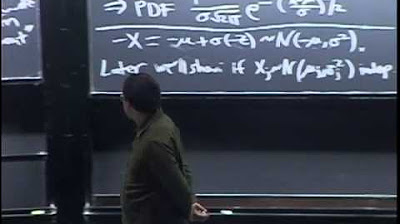Transforming a quadrilateral | Matrices | Precalculus | Khan Academy
TLDRThe video script discusses the application of a transformation matrix T, which is [3 0 0 3], to a red quadrilateral with unspecified coordinates. The讲师 suggests selecting arbitrary coordinates for the vertices of the quadrilateral to illustrate the transformation process. By multiplying the matrix with the position vectors of the vertices, the讲师 demonstrates that the transformation scales the quadrilateral by a factor of three, with each point being mapped to a new position three times its original distance from the origin. The讲师 concludes that the second sketch accurately represents the transformation of the red quadrilateral under matrix T.
Takeaways
- 📐 The given transformation matrix T is a 2x2 matrix with all off-diagonal elements as zero and diagonal elements as [3, 0; 0, 3].
- 🔍 The script provides a method for understanding how the transformation matrix T affects a red quadrilateral without specific coordinates given.
- 🤔 The audience is encouraged to pause the video and come up with their own coordinates for the quadrilateral to better understand the transformation process.
- 📌 The quadrilateral's vertices are assigned arbitrary coordinates (1,1), (1,-1), (-1,-1), and (-1,1) for the purpose of demonstration.
- 🤹 The transformation matrix T scales the x-coordinates by a factor of 3 and leaves the y-coordinates unchanged, as the off-diagonal elements are zero and do not affect the transformation.
- 📈 The transformed coordinates are calculated by matrix multiplication, resulting in new coordinates (3,3), (3,-3), (-3,3), and (-3,-3).
- 🎨 The script describes a visual representation of the transformation, showing how each point of the quadrilateral is mapped to a new position.
- 🏢 The second sketch is identified as the correct representation of the transformation matrix T being applied to the red quadrilateral.
- 🧠 The process illustrates the importance of understanding how each element of a transformation matrix affects the coordinates of a shape.
- 📚 The example serves as a lesson in matrix multiplication and its application in transforming shapes in 2D space.
Q & A
What is the given transformation matrix T?
-The given transformation matrix T is 3 0 0 3.
What is the significance of the vertices of the red quadrilateral in this context?
-The vertices of the red quadrilateral are the most useful points to consider when thinking about potential transformations, as they provide the essential information needed to understand how the shape will change.
How does the speaker suggest approaching the problem when no specific coordinates are given for the quadrilateral?
-The speaker suggests making up some coordinates for the red quadrilateral to see what would happen with the transformation, and encourages pausing the video to attempt it on their own first.
What are the assumed coordinates for the four vertices of the square?
-The assumed coordinates for the vertices are (1,1), (1,-1), (-1,-1), and (-1,1).
How does the transformation matrix T affect the x-coordinates of the points?
-The transformation matrix T multiplies the x-coordinates by 3, effectively scaling them up by a factor of three, as the y-coordinates are not involved in the multiplication with the first row of the matrix.
How does the transformation matrix T affect the y-coordinates of the points?
-The transformation matrix T is effectively multiplying the y-coordinates by 3 as well, since the second row of the matrix only involves the y-coordinates of the original points and the same multiplication factor (3) is applied.
What is the result of the transformation on the first vertex (1,1)?
-The first vertex (1,1) is transformed to the point (3,3) when multiplied by the matrix T.
Which of the sketches represents the transformation matrix T applied to the red quadrilateral?
-The second sketch is the one that represents the transformation matrix T being applied to the red quadrilateral.
What pattern does the speaker notice in the transformation process?
-The speaker notices that the transformation is essentially scaling each coordinate by a factor of three, as the x and y coordinates are multiplied by 3 and -3 respectively, without involving the other coordinate.
How does the transformation matrix T scale the points in the y-direction?
-The transformation matrix T scales the points in the y-direction in the same manner as the x-direction, by multiplying the y-coordinates by 3, as indicated by the second row of the matrix.
What is the final outcome of the transformation on all four vertices?
-The final outcome of the transformation is that all four vertices are scaled by a factor of three, resulting in the points (3,3), (3,-3), (-3,3), and (-3,-3).
Outlines
📐 Understanding Transformation Matrices
This paragraph delves into the concept of transformation matrices, specifically focusing on how the given matrix T, which is [3 0 0; 0 3; 0 0 1], can be applied to a red quadrilateral. The speaker encourages viewers to pause the video and come up with their own coordinates for the quadrilateral before revealing a set of example coordinates (1,1), (1,-1), (-1,-1), and (-1,1). The process of matrix multiplication is then explained, demonstrating how the transformation matrix scales the x-coordinates by a factor of three while leaving the y-coordinates unchanged. The result is a new set of coordinates (3,3), (3,-3), (-3,3), and (-3,-3), which are used to determine that the second sketch is the closest representation of the transformation applied to the red quadrilateral.
🎨 Visualizing Transformed Points
The second paragraph continues the discussion on the transformation of the red quadrilateral by visually mapping the original points to their transformed counterparts. The speaker confirms that the point (1,1) is correctly mapped to (3,3), and similarly, (1,-1) to (3,-3), (-1,1) to (-3,3), and (-1,-1) to (-3,-3). This visual confirmation reinforces the understanding of how the transformation matrix T operates, scaling the quadrilateral by a factor of three. The conclusion is that the second diagram accurately represents the effect of the transformation matrix on the red quadrilateral.
Mindmap
Keywords
💡Transformation Matrix
💡Vertices
💡Position Vector
💡Matrix Multiplication
💡Scaling
💡Coordinates
💡Column Vector
💡Hypothetical
💡Geometry
💡Linear Algebra
💡Visualization
Highlights
The transformation matrix T is given as 3 0 0 3.
The vertices of the red quadrilateral are the most useful points for potential transformations.
The video encourages the audience to pause and come up with their own coordinates for the red quadrilateral.
The speaker assumes the quadrilateral is a square for the sake of argument.
The position vectors for the square's corners are represented as column vectors: (1,1), (1,-1), (-1,-1), and (-1,1).
The transformation matrix is applied to the position vectors by multiplying it with a 2x4 matrix.
The multiplication results in a new 2x4 matrix, providing the transformed points' coordinates.
The transformation process scales each coordinate by a factor of three, ignoring the y-coordinate's initial influence.
The point (1,1) gets mapped to (3,3) after the transformation.
The point (1,-1) is transformed to (3,-3).
The point (-1,1) is mapped to (-3,3) after the transformation.
The point (-1,-1) gets transformed to (-3,-3).
The second diagram is identified as the one that best represents the transformation matrix T applied to the red quadrilateral.
The transformation is a simple scaling operation, with the matrix T effectively enlarging the square by a factor of three.
Transcripts
Browse More Related Video

Matrix transformation on triangle | Matrices | Precalculus | Khan Academy

Transformation matrix for position vector | Matrices | Precalculus | Khan Academy

Lecture 14: Location, Scale, and LOTUS | Statistics 110

INTEGRAL CALCULUS BETA GAMMA FUNCTION LECTURE 29 | BETA GAMMA FUNCTION SOLVED PROBLEM IN HINDI

INTEGRAL CALCULUS BETA GAMMA FUNCTION LECTURE 10

Lesson 8 - Calculus Curve Sketching Using Derivatives (Calculus 1 Tutor)
5.0 / 5 (0 votes)
Thanks for rating: